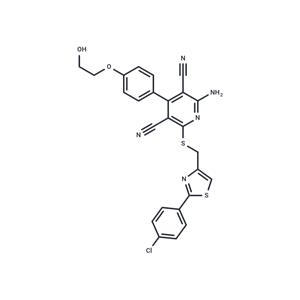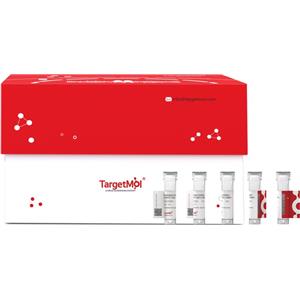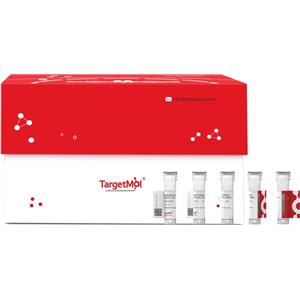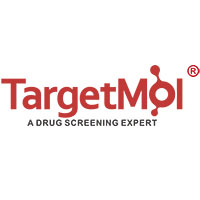
Capadenoson NEW
| Price | $35 | $53 | $109 |
| Package | 5mg | 10mg | 25mg |
| Min. Order: | |
| Supply Ability: | 10g |
| Update Time: | 2024-11-19 |
Product Details
| Product Name: Capadenoson | CAS No.: 544417-40-5 |
| Purity: 99.62% | Supply Ability: 10g |
| Release date: 2024/11/19 |
Product Introduction
Bioactivity
| Name | Capadenoson |
| Description | Capadenoson (BAY 68-4986) is a selective adenosine-A1 receptor agonist. |
| Kinase Assay | Membranes from the human cortex are prepared. [35S]GTPγS binding is measured. Briefly, 5 μg of membrane protein is incubated in a total volume of 160 μL for 2 hr at 25°C in a shaking water bath. [35S]GTPγS binding in control incubations and in the presence of Capadenoson showed a linear time course up to this incubation time. Binding buffer contained 50 mM Tris/HCl, pH 7.4, 2 mM triethanolamine, 1 mM EDTA, 5 mM MgCl2, 10 μM GDP, 1 mM dithiothreitol, 100 mM NaCl, 0.2 units/mL adenosine deaminase, 0.2 nM [35S]GTPγS, and 0.5% bovine serum albumin. Non-specific binding is determined in the presence of 10 μM GTPγS. Incubations are terminated through filtration of the samples over multiscreen FB glass fiber filters followed by two washes with binding buffer. The filters are dried, coated with scintillator and counted for radioactivity. Binding curves of [35S]GTPγS are analyzed by nonlinear regression using GraphPad Prism. |
| Animal Research | A total of 14 Wistar rats and 18 SHR (bodyweight 200-50 g, all-female) underwent experiments to evaluate the exocytotic, stimulation-induced NE release during electrical field stimulation. Rats are killed by an injection of pentobarbital i.p. (0.5 mL/100 mg body weight), and hearts are rapidly excised, and placed in ice-cold Krebs-Henseleit solution (KHL). They are quickly mounted on a Langendorff apparatus for retrograde perfusion with KHL. Perfusion rate is kept constant at 10 mL/min, the temperature is adjusted to 37°C, and the pH to 7.4 through bubbling with 5% CO2/95% O2. Via an inflow line desipramine at a concentration of 10?7 M is added to the perfusion buffer. After an equilibration period of 20 minutes, electrical field stimulation is commenced via two metal paddles adjacent to both sides of the beating heart for 1 minute (5V, 6 Hz). We collected the efflux in plastic tubes the minute before, during, and 3 minutes after the stimulation. These are rapidly frozen in liquid nitrogen and stored at ?20°C till analysis. The NE release is calculated as the cumulative release induced by electrical stimulation. After the first stimulation (S1), the study drug Capadenoson at concentrations of 30 μg/L (6×10^?8 M) or 300 μg/L(6×10^?7 M), or CCPA (10^?6 M), respectively, are added via separate perfusion lines for 30 minutes. After this time a second stimulation (S2) is executed to determine the effect of the drugs on NE release compared to the first stimulation. The effect of each pharmacological intervention is analyzed by calculating the ratio of NE release induced by the second and first stimulation (S2/S1 ratio). |
| In vitro | To elucidate the pharmacological effects of Capadenson, GTP shift assays compare its action to the A1-agonist CCPA and A1-antagonist DPCPX on rat cortical brain membranes. CCPA has a Ki value of 4.2 nM, which increases to 64 nM with 1 mM GTP, demonstrating a GTP shift of 15. Conversely, DPCPX displays a GTP shift of 1, indicating nearly unchanged Ki values with and without GTP. Capadenson presents a Ki value of 24 nM, escalating to 116 nM when exposed to 1 mM GTP, equating to a GTP shift of 5. This data highlights the distinct interactions of these compounds with GTP and their varied pharmacological profiles. |
| In vivo | In vivo experiments involving Wistar rats and SHR showed that pre-treatment with Capadenoson (0.15 mg/kg) for 5 days led to a consistent plasma concentration of the drug, averaging 7.63 μg/L on days 4 and 5. This level remained stable even after a 2-hour physical restraint stress test performed on day 5, administered 3 hours post Capadenoson intake, indicating steady absorption and efficacy throughout the pre-test period. |
| Storage | Powder: -20°C for 3 years | In solvent: -80°C for 1 year | Shipping with blue ice. |
| Solubility Information | DMSO : 70 mg/mL (134.61 mM) H2O : Insoluble |
| Keywords | Adenosine Receptor | Capadenoson | P1 receptor | Inhibitor | inhibit |
| Inhibitors Related | Theobromine | Theophylline | Doxofylline |
| Related Compound Libraries | Bioactive Compound Library | Membrane Protein-targeted Compound Library | Anti-Cancer Clinical Compound Library | Drug Repurposing Compound Library | Bioactive Compounds Library Max | GPCR Compound Library | Anti-Cancer Drug Library |
Company Profile Introduction
Target Molecule Corp. (TargetMol) is a global high-tech enterprise, headquartered in Boston, MA, specializing in chemical and biological research product and service to meet the research needs of global customers.
TargetMol has evolved into one of the biggest global compound library and small molecule suppliers and a customer based on 40+ countries. TargetMol offers over 80 types of compound libraries and a wide range of high-quality research chemicals including inhibitors, activator, natural compounds, peptides, inhibitory antibodies, and novel life-science kits, for laboratory and scientific use. Besides, virtual screening service is also available for customers who would like to conduct the computer-aided drug discovery.
You may like
Recommended supplier
| Product name | Price | Suppliers | Update time | |
|---|---|---|---|---|
| $15.00/1KG |
Zhuozhou Wenxi import and Export Co., Ltd
|
2021-07-10 | ||
| $1.00/1KG |
VIP6Y
|
Career Henan Chemical Co
|
2020-01-01 | |
| $15.00/1KG |
Zhuozhou Wenxi import and Export Co., Ltd
|
2021-07-08 |
- Since: 2011-01-07
- Address: 36?Washington?Street, Wellesley?Hills
INQUIRY







 United States
United States